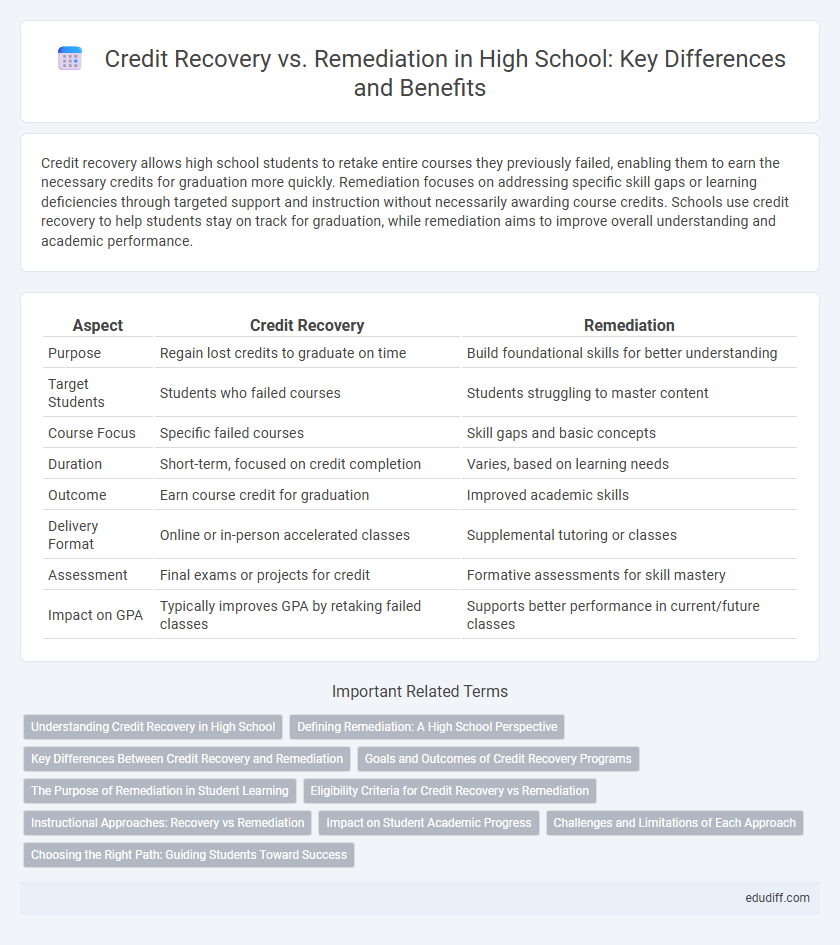Credit recovery allows high school students to retake entire courses they previously failed, enabling them to earn the necessary credits for graduation more quickly. Remediation focuses on addressing specific skill gaps or learning deficiencies through targeted support and instruction without necessarily awarding course credits. Schools use credit recovery to help students stay on track for graduation, while remediation aims to improve overall understanding and academic performance.
Table of Comparison
| Aspect | Credit Recovery | Remediation |
|---|---|---|
| Purpose | Regain lost credits to graduate on time | Build foundational skills for better understanding |
| Target Students | Students who failed courses | Students struggling to master content |
| Course Focus | Specific failed courses | Skill gaps and basic concepts |
| Duration | Short-term, focused on credit completion | Varies, based on learning needs |
| Outcome | Earn course credit for graduation | Improved academic skills |
| Delivery Format | Online or in-person accelerated classes | Supplemental tutoring or classes |
| Assessment | Final exams or projects for credit | Formative assessments for skill mastery |
| Impact on GPA | Typically improves GPA by retaking failed classes | Supports better performance in current/future classes |
Understanding Credit Recovery in High School
Credit recovery in high school allows students to retake courses they have failed to earn necessary credits for graduation without repeating the entire class. This targeted approach helps students stay on track by focusing on specific skills and standards they did not master initially. Online platforms and personalized learning plans often support credit recovery, providing flexibility and tailored instruction to improve academic outcomes.
Defining Remediation: A High School Perspective
Remediation in high school refers to targeted instruction designed to address students' academic deficiencies and build foundational skills needed for success in grade-level content. It often involves personalized learning plans, frequent progress monitoring, and support in core subjects like math, reading, and science. Effective remediation closes learning gaps and prepares students to meet state standards and graduate on time.
Key Differences Between Credit Recovery and Remediation
Credit recovery programs allow high school students to retake specific courses to earn academic credits needed for graduation, focusing on mastering content after failing. Remediation focuses on identifying and addressing underlying skill gaps, such as literacy or math deficiencies, through targeted instruction without necessarily awarding course credits. The key difference lies in credit recovery's emphasis on credit accumulation for graduation versus remediation's goal of skill improvement to support overall academic success.
Goals and Outcomes of Credit Recovery Programs
Credit recovery programs aim to help high school students regain credits for courses they previously failed or missed, enabling timely graduation and preventing dropout. These programs focus on mastering specific course content through personalized, accelerated learning pathways, often using online or blended instruction models. The outcomes emphasize credit attainment and academic progress, improving graduation rates and student self-efficacy in challenging subjects.
The Purpose of Remediation in Student Learning
Remediation in high school focuses on reinforcing foundational skills students have not yet mastered, ensuring they achieve grade-level competency. It aims to address specific learning gaps through targeted instruction that supports long-term academic success. This personalized approach helps students build confidence and prepares them for future coursework, distinguishing it from credit recovery programs that primarily target course completion.
Eligibility Criteria for Credit Recovery vs Remediation
Credit recovery eligibility typically requires students to have failed a specific course but demonstrated partial mastery or attendance, allowing them to earn credit through condensed or alternative instruction. Remediation eligibility is broader, targeting students who struggle with fundamental skills or standardized assessments, often without prior course failure but needing foundational support to meet grade-level proficiency. Schools use assessment results, teacher recommendations, and academic records to determine the most appropriate intervention between credit recovery and remediation.
Instructional Approaches: Recovery vs Remediation
Credit recovery programs in high schools utilize targeted, accelerated instruction to help students regain course credits quickly, often through online modules or focused assignments aimed at mastering specific standards. Remediation emphasizes foundational skill-building through individualized or small-group instruction, addressing underlying gaps in knowledge to ensure students achieve grade-level proficiency. While credit recovery prioritizes credit attainment with concise content review, remediation invests more time in comprehensive skill reinforcement and conceptual understanding.
Impact on Student Academic Progress
Credit recovery allows high school students to regain lost credits efficiently, enabling timely graduation and maintaining academic momentum. Remediation focuses on strengthening foundational skills, which can improve long-term understanding but may delay credit completion. Schools balancing these approaches can optimize student success by addressing immediate credit needs while supporting comprehensive learning growth.
Challenges and Limitations of Each Approach
Credit recovery programs face challenges such as accelerated pacing that may overwhelm students and limit deep understanding of content. Remediation often struggles with low student motivation and engagement, leading to inadequate mastery of foundational skills. Both approaches can be constrained by limited resources and insufficient personalized support, impacting overall academic success.
Choosing the Right Path: Guiding Students Toward Success
Credit recovery programs allow high school students to earn missed credits at an accelerated pace, focusing on mastering specific course content to stay on track for graduation. Remediation emphasizes foundational skill-building in subjects where students show significant gaps, ensuring long-term academic success through targeted intervention. Choosing the right path depends on assessing each student's learning needs, academic goals, and graduation timeline to provide personalized support that maximizes achievement.
Credit Recovery vs Remediation Infographic

 edudiff.com
edudiff.com